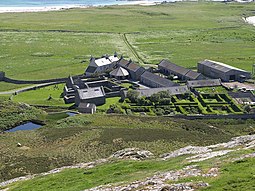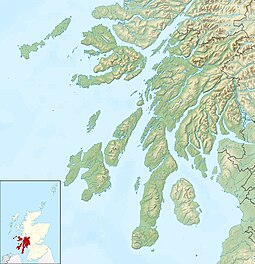Oronsay, Inner Hebrides
| Gaelic name | |
|---|---|
| Norse name | possibly Örfirisey |
| Meaning of name | "tidal island" or "Oran's isle" |
 Oronsay Priory and Farm |
|
| Location | |
|
Oronsay shown within Argyll and Bute
|
|
| OS grid reference | NR351892 |
| Coordinates | 56°01′N 6°14′W / 56.02°N 6.24°W |
| Physical geography | |
| Island group | Inner Hebrides |
| Area | 543 hectares (1,340 acres) |
| Area rank | 71 |
| Highest elevation | Beinn Orasaigh 93 m (305 ft) |
| Administration | |
| Sovereign state | United Kingdom |
| Country | Scotland |
| Council area | Argyll and Bute |
| Demographics | |
| Population | 8 |
| Population rank | 70= |
| Population density | 1.5 people/km2 |
| Largest settlement | Oronsay Farm |
| References | |
Oronsay (Scottish Gaelic: Orasaigh, pronounced [ˈɔɾəs̪aj]), also sometimes spelt and pronounced Oransay by the local community, is a small tidal island south of Colonsay in the Scottish Inner Hebrides with an area of 543 hectares (1,340 acres).
The island rises to a height of 93m (305 feet) at Beinn Orasaigh and is linked to Colonsay by a tidal causeway (called An Traigh (The Strand)) consisting of sands and mud flats. In the 2001 census Oronsay was recorded as having a population of five people, who lived at the farm adjacent to Oronsay Priory. In 2011 the population had risen to eight. The island has no facilities for visitors, and is dependent upon its tidal access to and from Colonsay. There is a small grass air strip south of the priory that "fights a losing battle with the rabbits".
There are two theories for the origin of the name from Old Norse. Either it is Oran's Isle, St Oran being the founder of the island's original monastery in 563, (Murray (1966) states that the original Gaelic name was Eilean Orain) or it may be from the Old Norse Örfirisey meaning "island of the ebb tide".
Both Oronsay and neighbouring Colonsay have furnished archaeologists with invaluable information about the Mesolithic period of prehistory, particularly about the diet of human beings. Three middens on Oronsay were opened in the 1880s and have provided a piece of bone carbon-dated to 4600 BC and an oyster shell to 3065 BC. Evidence provided from saithe bones in the middens suggest that the local population lived there all year round and were heavily reliant on marine protein. Site datings on Colonsay and Islay suggest an absence of human habitation in the area from c.5250-4750 BC for unknown reasons.
...
Wikipedia

